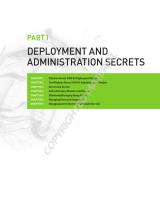
Dell DL1300 Smart Agent
The Smart Agent is installed on the core-protected machine. The Smart Agent tracks the changed blocks
on the disk volume and then snaps an image of the changed blocks at a predefined interval of protection.
The incremental block-level snapshots’ forever approach prevents repeated copying of the same data
from the protected machine to the Core.
After the agent is configured, it uses smart technology to track the changed blocks on the protected disk
volumes. When the snapshot is ready, it is rapidly transferred to the Core using intelligent multi-threaded,
socket-based connections.
Snapshot process
Your DL1300 protection process begins when a base image is transferred from a protected machine to
the Core. In this phase, full copy of the machine is transported across the network under normal
operation, followed by incremental snapshots forever. The DL1300 Agent for Windows uses Microsoft
Volume Shadow copy Service (VSS) to freeze and quiesce application data to disk to capture a file-
system-consistent and an application-consistent backup. When a snapshot is created, the VSS writer on
the target server prevents content from being written to the disk. During the process of halting of writing
content to disk, all disk I/O operations are queued and resume only after the snapshot is complete, while
the operations in progress will be completed and all open files will be closed. The process of creating a
shadow copy does not significantly affect the performance of the production system.
Your DL1300 uses Microsoft VSS because it has built-in support for all Windows internal technologies
such as NTFS, Registry, Active Directory, to flush data to disk before the snapshot. Additionally, other
enterprise applications, such as Microsoft Exchange and SQL, use VSS Writer plug-ins to get notified
when a snapshot is being prepared and when they have to flush their used database pages to disk to
bring the database to a consistent transactional state. The captured data is rapidly transferred and stored
on the Core.
Replication — disaster recovery site or service provider
Replication is the process of copying recovery points from an Rapid Recovery core and transmitting them
to another Rapid Recovery core in a separate location for disaster recovery. The process requires a paired
source-target relationship between two or more cores.
The source core copies the recovery points of selected protected machines, and then asynchronously
and continually transmits the incremental snapshot data to the target core at a remote disaster recovery
site. You can configure outbound replication to a company-owned data center or remote disaster
recovery site (that is, a “self-managed” target core). Or, you can configure outbound replication to a
third-party managed service provider (MSP) or cloud provider that hosts off-site backup and disaster
recovery services. When replicating to a third-party target core, you can use built-in work flows that let
you request connections and receive automatic feedback notifications.
Replication is managed on a per-protected-machine basis. Any machine (or all machines) protected or
replicated on a source core can be configured to replicate to a target core.
Replication is self-optimizing with a unique Read-Match-Write (RMW) algorithm that is tightly coupled
with deduplication. With RMW replication, the source and target replication service matches keys before
transferring data and then replicates only the compressed, encrypted, deduplicated data across the WAN,
resulting in a 10x reduction in bandwidth requirements.
8





















